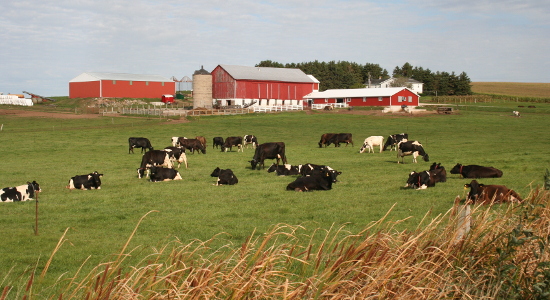
A six year dispute between the developers of the proposed Golden Sands Dairy in Saratoga and their local township has finally been settled by the state’s highest court. Wisconsin Supreme Court justices ruled on Tuesday that the Wysocki Family of Companies can expand their dairy, despite an April 2017 decision by the District IV Court of Appeals that stated the farm would not be able to use more than 6,000 acres of nearby land for manure spreading or other agricultural purposes because of a local ordinance instituted by the town board.
The dairy wants to house 5,300 animals on the site, which would generate 55 million gallons of liquid manure and another 25,000 tons of solid waste each year. But neighbors have been concerned that the manure would contaminate local drinking water and increase traffic on their local roads.
The Wisconsin Supreme Court has ruled in favor of a dairy farm seeking to run a large-scale operation within the Town of Saratoga based on a building permit application the farm filed before the town rezoned the area to prohibit agricultural uses.
Golden Sands Dairy filed a building permit application to build seven structures on 93 acres. The application also identified the 6,388 acres of the operation’s open farmland. The town then enacted a zoning ordinance to prohibit agricultural uses in that area.
But Golden Sands Dairy filed a lawsuit, claiming that its building permit application – which strictly complied with the applicable zoning regulations in place when filed – gave the farm a vested right to build the buildings and to farm the other 6,388 acres.
In Wisconsin, the so-called Building Permit Rule grants a private party vested rights to build structures upon the filing of a conforming building permit application.
Golden Sands Dairy argued that the Building Permit Rule extended to uses of land identified in the permit application. A circuit court ruled in favor of the farm, but an appeals court reversed, concluding vested rights in the permit did not extend to all land.
In Golden Sands Dairy LLC v. Town of Saratoga, 2018 WI 61 (June 5, 2018), a Supreme Court majority (5-2) reversed the appeals court, concluding that Golden Sands had a vested right in the land identified in the building permit application.
“We hold that the Building Permit Rule extends to all land specifically identified in a building permit application,” wrote Justice Michael Gableman. “Consequently, Golden Sands has a vested right to use all of the Property for agricultural purposes.”
Zoning vs. Permit
In its 2012 building permit application, Golden Sands Dairy attached a map that showed the location of proposed building structures and shaded areas for open farmland. At the time, Saratoga had no zoning ordinances in place that restricted use of the land.
However, Saratoga began developing a comprehensive zoning plan and passed a moratorium on building permits two days after Golden Sands Dairy filed an amended building permit application. A few months later, the town passed a zoning ordinance.
Golden Sands Dairy filed a mandamus action and the circuit court ultimately granted the writ and ordered Saratoga to grant the building permit application. That did not end the matter, since Golden Sands Dairy wanted assurances about using the land.
In a subsequent declaratory judgment action, the farm asked the court to declare that the building permit covered the land that was identified in the application.
The circuit court ruled in favor of Golden Sands Dairy, but the appeals court reversed on the grounds that rights to build structures and rights to use land are different. In other words, the farm had to establish a nonconforming use before the zoning ordinance took effect, and Golden Sands Dairy could not rely on the Building Permit Rule.
Supreme Court Majority Rules
The majority explained that Wisconsin is among a minority of states that adheres to the Building Permit Rule, granting vested rights upon the filing of a building permit application that conforms with all applicable zoning laws when the application is filed.
In a majority of states, vested rights don’t trigger without substantial construction or expenditures related to the building project that is the subject of the permit, allowing the government to change its mind about zoning before a project gets off the ground.
The Supreme Court said the Building Permit Rule is intended to add predictability with respect to building projects, it is “simple for parties to interpret and courts to apply,” and that predictability should extend to the land associated with such building projects.
“We conclude that the primary policy underlying the bright-line Building Permit Rule – predictability – is best advanced by applying the rule to all land specifically identified in the building permit application,” Justice Gableman wrote for the majority.
“Such a rule ensures that all parties know when rights vest in what land: the time a building permit application that strictly complies with all zoning regulations is filed.”
Justice Gableman said building permits would be “nearly worthless” if they don’t extend to the land necessary to put them to use. In addition, the majority explained that any unused land may be subject to zoning regulations when the building permit expires.
“[I]f Golden Sands overestimated the amount of land it needs to operate the farm, the land not in use at the time the building permit expires would not benefit from either the Building Permit Rule or the nonconforming use doctrine,” Justice Gableman wrote.
Dissent
Justice Shirley Abrahamson dissented, joined by Justice Ann Walsh Bradley, arguing the majority’s decision expands the Building Permit Rule and creates less predictability since an applicant must “specifically identify” land in a building permit application.
“At what point will a map lack sufficient detail to ‘specifically identify’ the land at issue? Simply asking this question indicates that the majority has injected uncertainty into the application of the Building Permit Rule where it did not previously exist,” she wrote.
Source: wisbar.org









